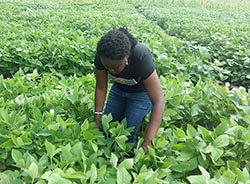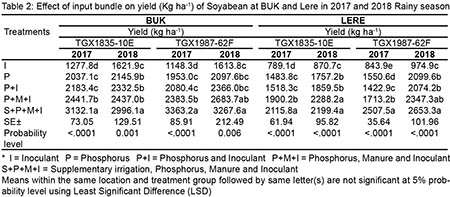Introduction: Soyabean is an important crop in Nigeria, that has gradually evolved to be a crucial cash crop for rural households in the Nigerian Savannas due to its rising industrial demand. Nigeria is the second largest producer of soyabean after South Africa producing 700,000 Mt of soyabean per year. Despite its growing importance in the Nigeria savannas, soyabean yields are low due to several production constraints including poor soil fertility with emphasis on phosphorus, intermittent drought and low biological nitrogen fixation by adapted varieties. This study was carried out to assess the effect of integrated input management systems on productivity of soyabean in the Nigeria savannas.
| Methodology: Field experiments were conducted during the 2017 and 2018 cropping seasons at the experimental site of Bayero University Kano (BUK), in the Sudan Savanna and at the IITA experimental site in Lere in the Northern Guinea Savanna of Nigeria to evaluate the use of input bundles in soyabean production systems. The treatments consisted of two soyabean varieties (TGX 1835-10E and TGX 1987-62F) and five input bundles: Supplementary irrigation + Phosphorus + Manure + Inoculant (S+P+M+I) (T1), Phosphorus + Manure + Inoculant (P+M+I) (T2), Phosphorus + Inoculant (P+I) (T3), Phosphorus only (P) (T4) and the control which is Inoculant only (I) (T5). The experimental design was a Randomized Complete Block Design with three replications. Plot size was 3m × 5m long consisting of four ridges with spacing of 75 cm between rows and 10 cm within rows. |  Rainfed soyabean with integrated input bundle (S+P+M+I) that is Supplementary irrigation + Phosphorus fertilizer+ Manure + Inoculant |
Methodology: Field experiments were conducted during the 2017 and 2018 cropping seasons at the experimental site of Bayero University Kano (BUK), in the Sudan Savanna and at the IITA experimental site in Lere in the Northern Guinea Savanna of Nigeria to evaluate the use of input bundles in soyabean production systems. The treatments consisted of two soyabean varieties (TGX 1835-10E and TGX 1987-62F) and five input bundles: Supplementary irrigation + Phosphorus + Manure + Inoculant (S+P+M+I) (T1), Phosphorus + Manure + Inoculant (P+M+I) (T2), Phosphorus + Inoculant (P+I) (T3), Phosphorus only (P) (T4) and the control which is Inoculant only (I) (T5). The experimental design was a Randomized Complete Block Design with three replications. Plot size was 3m × 5m long consisting of four ridges with spacing of 75 cm between rows and 10 cm within rows.
Results: The effect of input bundles on nodule number and grain yield of soyabean are shown in Table 1 and 2. The results show that, different input bundles significantly influenced number of nodule plant-1 and grain yield. The application of input bundle S+P+M+I consistently produced the highest nodule number plant-1 and grain yield for both varieties in each location (Table 1 and 2). The input bundle S+P+M+I produced 65.9% higher grain yield at BUK and 66.3% at Lere over input bundle I for the two varieties. This result indicates that the combination of input such as phosphorus, inoculant, manure and supplementary irrigation will increase soyabean grain yield in the savannas. There was generally no response to inoculation with Bradyrhizobium when no phosphorus was applied to the soyabean varieties.
 |
 |
Jenneh Bebeley, Bayero University Kano, Kano State, Nigeria.
